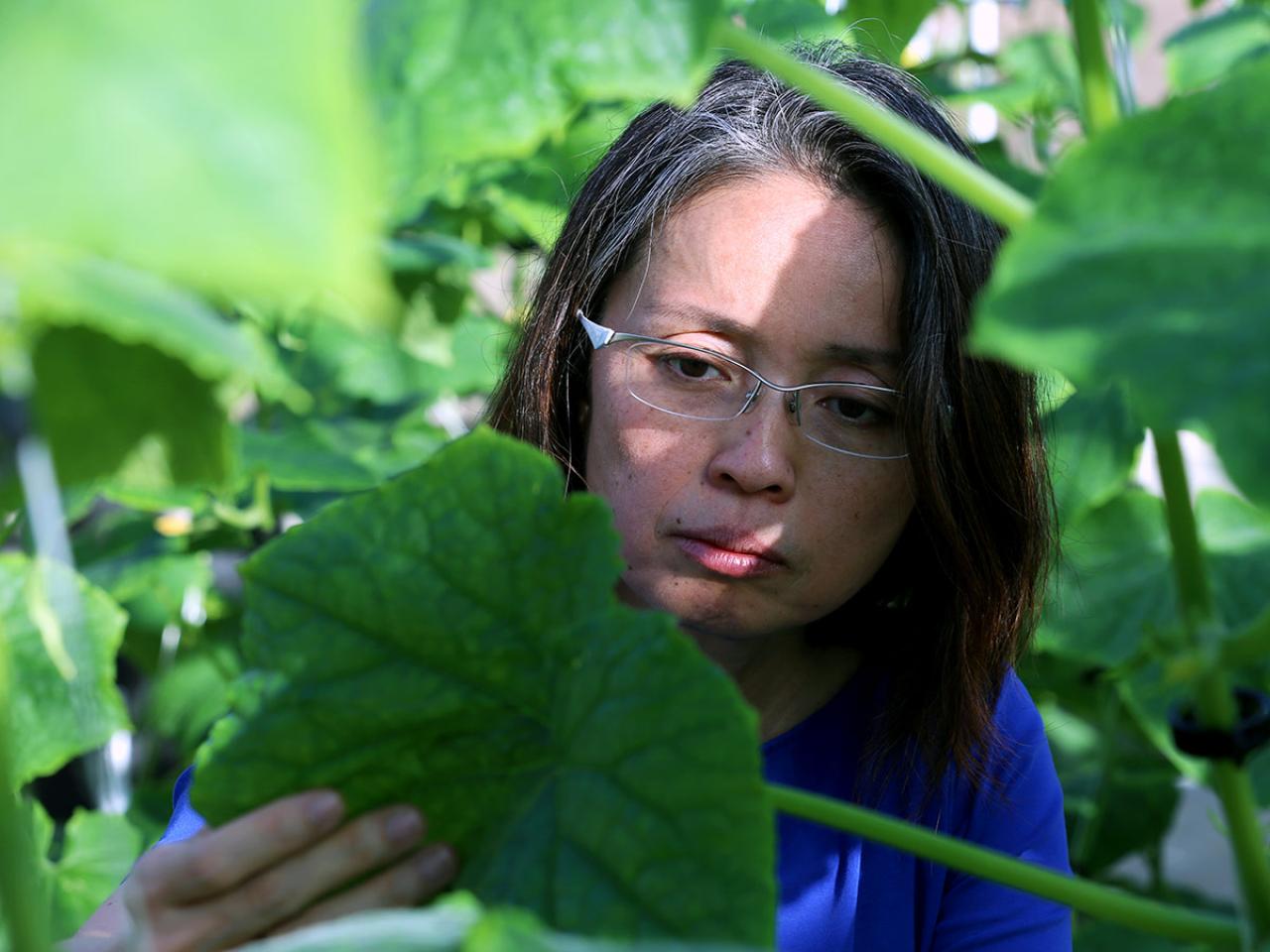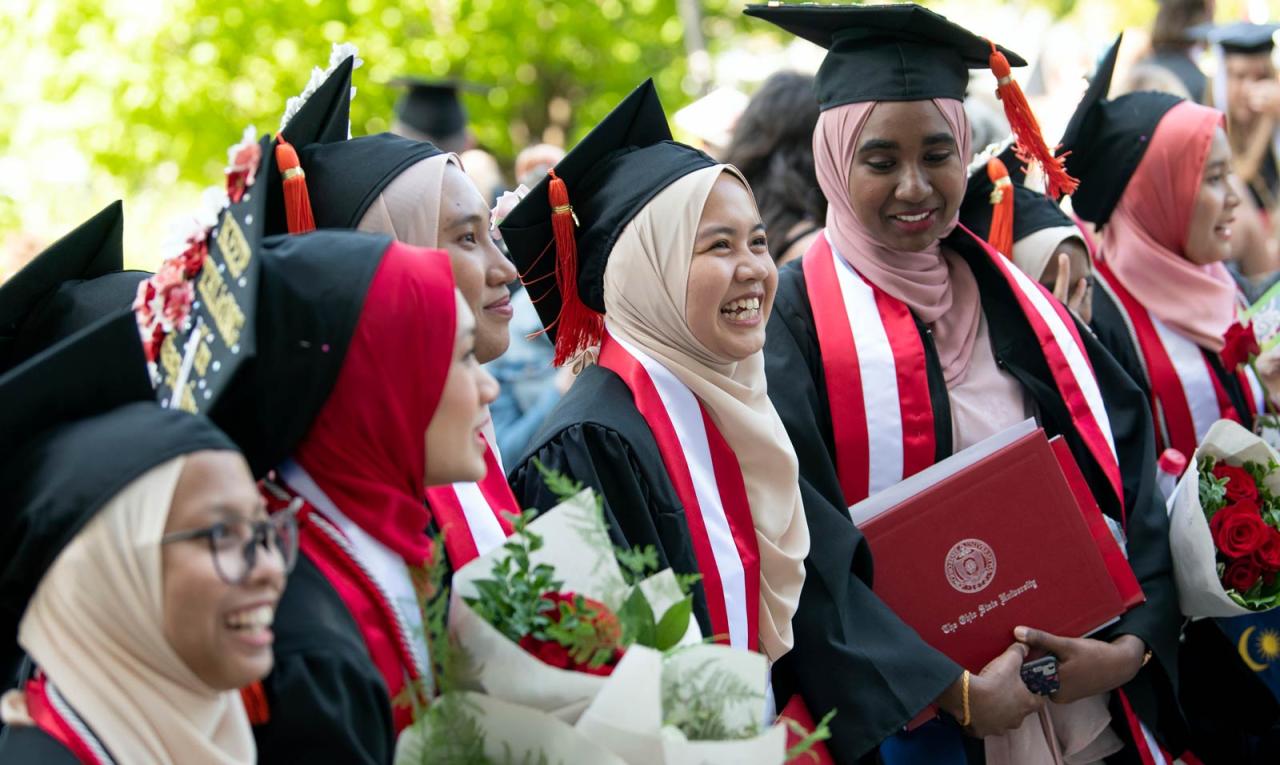
Chieri Kubota’s world is lush greens and pops of red. Vines of peppers and tomatoes that stretch toward a glass ceiling. Under her watch, a hydroponic system inside an Ohio State greenhouse nourishes lettuce and herbs, cucumbers and strawberries as they bask under sunlight until darkness triggers an LED light sensor.
It’s been a solid system for Kubota to teach Ohio State’s students the intricacies of greenhouse horticulture and engineering while she continues valuable research for those in the indoor farming industry. However, a considerable upgrade is on the way.
Ohio State will break ground in 2020 on the Controlled Environment Food Production Research Complex at Waterman Agricultural and Natural Resources Laboratory. It will be a first-of-its-kind academic facility that will allow Kubota and her students to continue to research and develop cutting edge greenhouse horticultural techniques.
“It will allow us to do a lot of different research and explore sophisticated approaches to greenhouse technology that aren’t available at any other institutions,” said Kubota, professor of Controlled Environment Agriculture within the College of Food, Agricultural and Environmental Sciences and faculty lead on the Research Complex project.
Kubota’s knowledge and research on controlled environment agriculture has been critical to the rise of the U.S. controlled environment agriculture industry since she arrived at the University of Arizona from Tokyo in 2002. It’s research that helps greenhouse growers continue to create jobs and produce fruits and vegetables for local stores and restaurants while vastly cutting the resources they use. When compared to outdoor farms, most greenhouse and indoor farms use 90% less water and little pesticides or herbicides, and significantly reduce food waste because of local shipping.
“Greenhouses and indoor farms have a very efficient system,” Kubota said. “There is only so much you can do in open fields but there’s tons you can do in controlled environments. As an extreme case, indoor farms use electrical lighting such as LEDs and do not need to rely on sunlight.”
“I’m interested in how can I help make production more efficient, more profitable and more friendly to the environment? Can we go further? I’m sort of pushing the edge.”
The possibility of the new facility is one reason Kubota came to Ohio State in 2017. And having her lead the effort is a major reason the project moved forward.
“I wonder if we would have gotten the support for this new facility if it hadn’t been for Chieri,” said Jim Metzger, professor and chair of Ohio State’s Department of Horticulture and Crop Science, who helped recruit Kubota to Ohio State. “She’s highly recognized nationally and internationally. People seek her out, whether it’s citing her in academic publications or companies sending employees to her workshops.”
Kubota’s research has produced more than 200 academic articles. Her online Indoor Ag Science Café, in which she and others deliver webinars, has more than 400 members, including those from the indoor farming community, academics, greenhouse engineers and technology producers. Also, she’s one of three team members on the Scientific Advisory Board for GLASE (Greenhouse Lighting and Systems Engineering), a national consortium that aims to pioneer groundbreaking greenhouse technology.
Her research is boosting greenhouse and indoor farming industries that have shown tremendous growth in the United States this past decade. The 2019 USDA census shows a 132% increase in greenhouse production for vegetables and herbs from 2012 to 2017 in the United States.
The state with the largest growth? Ohio, at 292%.
With greenhouse growth in the state, the numerous horticultural industries and technology providers that surround Ohio and the chance to conduct research in a more seasonal climate, Kubota saw a wealth of opportunities when she arrived at Ohio State.
“I have a skillset and I want to be helpful,” she said. “I want my research to contribute in a major way.”

'She's helped with everything'
Surrounded by corn and soybean fields in the rural town of St. Paris, Ohio, is Old Souls Farms, an indoor farm that produces lettuce, basil and arugula that Ohioans can find in supermarkets and restaurants year-round.
And like most indoor and greenhouse farmers, Old Souls Farms produces these leafy greens in a much more sustainable way.
For example, Old Souls Farms’ hydroponic system combines collected rainwater and fertilizer to feed crops. The water is recycled and used again. This averages out to four times less water usage than the average American household. Also, no pesticides or herbicides are used on their products and the greenhouse is designed to optimize sunlight use as much as possible.
“There are a lot of sustainability benefits, and that’s something that’s near and dear to our hearts,” said Ethan Snyder, the owner of Old Souls Farms. “It’s our opinion sustainability is best viewed through the lens of what’s natural. As unnatural as this sometimes seems, we actually try to make use of as many natural processes as possible. And when we do that, it actually makes us more sustainable and actually drives a better bottom line.”
Snyder founded Old Souls Farms in January 2017, shortly before meeting Kubota, who has grown into an incredible ally for the growth of the farm.
“She’s helped with everything,” Snyder said. “Ten minutes of her walking around is enough for her to see all sorts of things. She has this combination of horticultural and engineering knowledge and that’s rare.
“At the end of the day, a lot of the problems we face we solve with engineering science. It’s a different type of farming. It’s not sitting on a tractor. Whether it’s the lighting or designing a cooling system or designing the structure itself, that combination is important. When you walk into a greenhouse, you have to be paying attention to both the crops and the greenhouse itself.”
Old Souls Farm harvests about 4,000 plants per day in its 35,000-square-foot greenhouse. But Snyder is planning a 10-acre expansion that will allow him to produce more lettuce, with an eye toward growing tomatoes, cucumbers, peppers and strawberries in the future. It also will take his business from 25 employees to about 120, including engineers, chemists, biologists and pest and disease control specialists.
Many indoor farms offer a similarly wide variety of jobs, according to Snyder. But these are hard jobs to fill because of how new the industry is to the United States. That’s where Kubota’s students, who gain a deep understanding of her horticultural engineering techniques, are critical.
“In controlled environment production, you really need to understand the system,” Kubota said. “The system is creating the climate, and plants are responding to that climate and influence that climate. So it’s important to understand all functions.
“But U.S. education hasn’t quite integrated that yet. It doesn’t function like my vision for my students. I don’t want to limit my students; I like to give them an interdisciplinary opportunity.”
John Ertle, a master’s student in Kubota’s lab, said this marriage of engineering and agriculture is opening up a world of problem-solving opportunities in the food production industry. For example, 10 years ago Kubota introduced growing strawberries indoors in the United States. Gradually, indoor farmers began producing strawberries, including one farm in Ohio. She’s hoping to produce raspberries and blueberries in the future.
“Her engineering approach to agriculture means she can grow berries in Ohio in off-peak production months and produce a higher quality than you’d normally find in a store,” Ertle said. “If you apply engineering principles in greenhouse production — you install lighting, heating and cooling units, temperature sensors, humidity sensors — you can change the environment and can use technology to solve problems you couldn’t solve before.”

Professor Chieri Kubota introduced greenhouse strawberry production to the United States about 10 years ago. Students in Kubota’s lab such as Tom McKean, now a horticultural research scientist, gain not only a thorough education in crop production but on greenhouse engineering. It’s a combination of skills that sets Kubota’s students ahead of the pack.
Impact in action
Ohio State’s new Controlled Food Production Research Complex will be a first-of-its-kind academic greenhouse facility. It will allow Professor Chieri Kubota to continue groundbreaking research for the indoor farming community as students learn cutting edge methods of hydroponic crop production and greenhouse engineering. This facility combined with Ohio State’s expertise in this greenhouse horticulture is situated perfectly in the center of a booming industry landscape. Ohio led the nation with a 292% expansion of greenhouse areas for vegetables and herbs from 2012 to 2017, according to a 2019 USDA census. Pennsylvania was second with 133% growth in that time.
"Next-generation agriculture is attracting students. But it’s not an easy subject to learn just by reading. You have to have hands-on training to understand plant biology and facility technologies. You have to balance that knowledge. Students need that training program and that’s why I’m here."
Chieri Kubota
Professor of Controlled Environment Agriculture

Be a champion for students.
When you invest in people, you invest in the belief that together, we can change lives and move communities forward.


